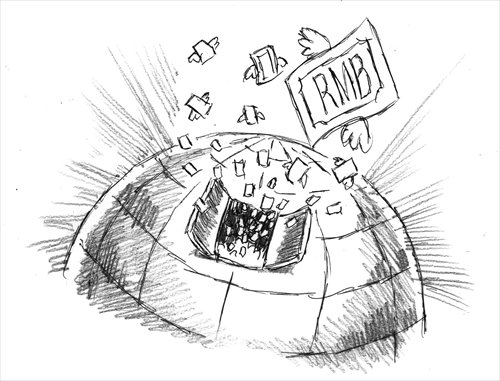HOME >> BUSINESS
Domestic market drives yuan bond investors
By Jenny Shi Source:Global Times Published: 2015-5-19 21:13:01
Govt aims to promote further investment from abroad

Illustration: Peter C. Espina/GT
Given its size and the breadth of its issuer base, China's domestic bond market offers more investment options for global investors than the offshore yuan bond market, making it a key driver for the internationalization of yuan bonds.
China is increasingly lifting controls over its domestic bond market and media reports on May 4 said that the authorities have just given approval for 32 foreign institutions to invest in this market.
According to domestic news portal yicai.com, these institutions have secured approval to invest specifically in the interbank bond market, where over 90 percent of all Chinese domestic bonds are traded.
Offshore investors can invest in domestic yuan bonds through the Renminbi Qualified Foreign Institutional Investor (RQFII), Qualified Foreign Institutional Investor (QFII) and the People's Bank of China's (PBC) Interbank Investment programs. These three platforms collectively held 536 billion yuan ($86.4 billion) in onshore bonds as of December 2014, according to the China Central Depository and Clearing Co.
In comparison, the total outstanding amount of offshore yuan bonds, excluding certificates of deposit, stood at 490 billion yuan as of December 2014. As such, the domestic yuan bond market has become an important investment avenue for international investors
The QFII program was first launched in 2003. Upon obtaining approval from the China Securities Regulatory Commission, an investment quota was assigned to determine the investment ceiling for each investor. At the end of April 2015, the number of institutions and their total QFII investment quotas had increased to 268 and $73.62 billion respectively.
In recent years, China has significantly expanded foreign access to its domestic bond market. For instance, the State Administration of Foreign Exchange (SAFE), the foreign exchange regulator, on March 26 lifted the $1 billion investment quota limit for overseas private institutions as part of efforts to further open up the domestic capital market.
Similar moves were also seen in the RQFII program, launched by the government in 2011. Since that time, the investment quota has increased 15 times over, from 20 billion yuan to 363.7 billion yuan as of April 2015, and the investor base has also become much more diversified, now including investors from Hong Kong, Singapore, the UK, France and South Korea, most of whom joined in the second half of 2014.
Given its size and issuer diversity, the domestic bond market now offers more investment options than the offshore yuan bond market.
However, the domestic bond market still remains a developing domestic currency market. Compared with developed markets, there is much room for improvement on disclosure requirements and investor protection mechanisms. For instance, domestic yuan bond documents contain virtually no covenants, and China's insolvency and liquidation regimes are evolving.
These factors pose challenges for international investors looking to invest in the domestic market, but ongoing reforms should help further improve transparency and the development of an efficient credit-risk-based bond market.
As for offshore yuan bonds, issuance is expected to continue growing this year, even as the US dollar strengthens and interest rates fall in the onshore market and, at the same time, more types of issuers and debt products enter this market.
The offshore yuan markets have achieved several key milestones in the past 12 months, underlining the progress of China's currency toward the status of an important international asset class.
The first milestone is a growing non-Chinese issuer base, most notably to include G7 sovereigns and sub-sovereigns. The second is both growing cross-border trade and foreign-exchange trading activities, with the yuan now the fifth most-traded currency globally after the US dollar, euro, sterling and yen. The third is the proliferation of offshore yuan trading centers in cities in Europe and North America, and the fourth is the growing number of bilateral currency agreements between the PBC and other central banks.
While the US dollar/yuan exchange rate is still an important driver for growth in the offshore yuan bond markets, especially in the short term, growth in the long term will require the recognition and penetration of the yuan in international markets, underpinned by a stable exchange rate.
In addition, more regional State-owned enterprises and Chinese non-bank financial institutions will make debut issuances as they broaden their funding channels. Meanwhile, more governments worldwide are expected to tap the yuan bond market to promote offshore yuan transactions.
The author is managing director and China country manager for the global credit rating agency Moody's Investors Service. bizopinion@globaltimes.com.cn
Posted in: Comments